REVOLUTIONIZING THE FUTURE OF BANKING: HOW DIGITAL BANKS ARE POSITIVELY DISRUPTING AND TRANSFORMING THE INDUSTRY FOR A BRIGHT TOMORROW
The banking industry is undergoing a significant transformation, driven by technological advancements and changing consumer behavior. Digital banks are at the forefront of this revolution, offering innovative solutions that are challenging traditional banking models. In this article, we’ll explore the rise of digital banks, their impact on the industry, and what this means for consumers.
WHAT ARE DIGITAL BANKS?
Digital banks, also known as neobanks or challenger banks, are financial institutions that operate entirely online or through mobile apps. They offer a range of financial services, including checking and savings accounts, credit cards, loans, and investment products. Digital banks are designed to be more agile, efficient, and customer-centric than traditional banks.
THE EMERGENCE OF DIGITAL BANKS: A NEW ERA IN BANKING
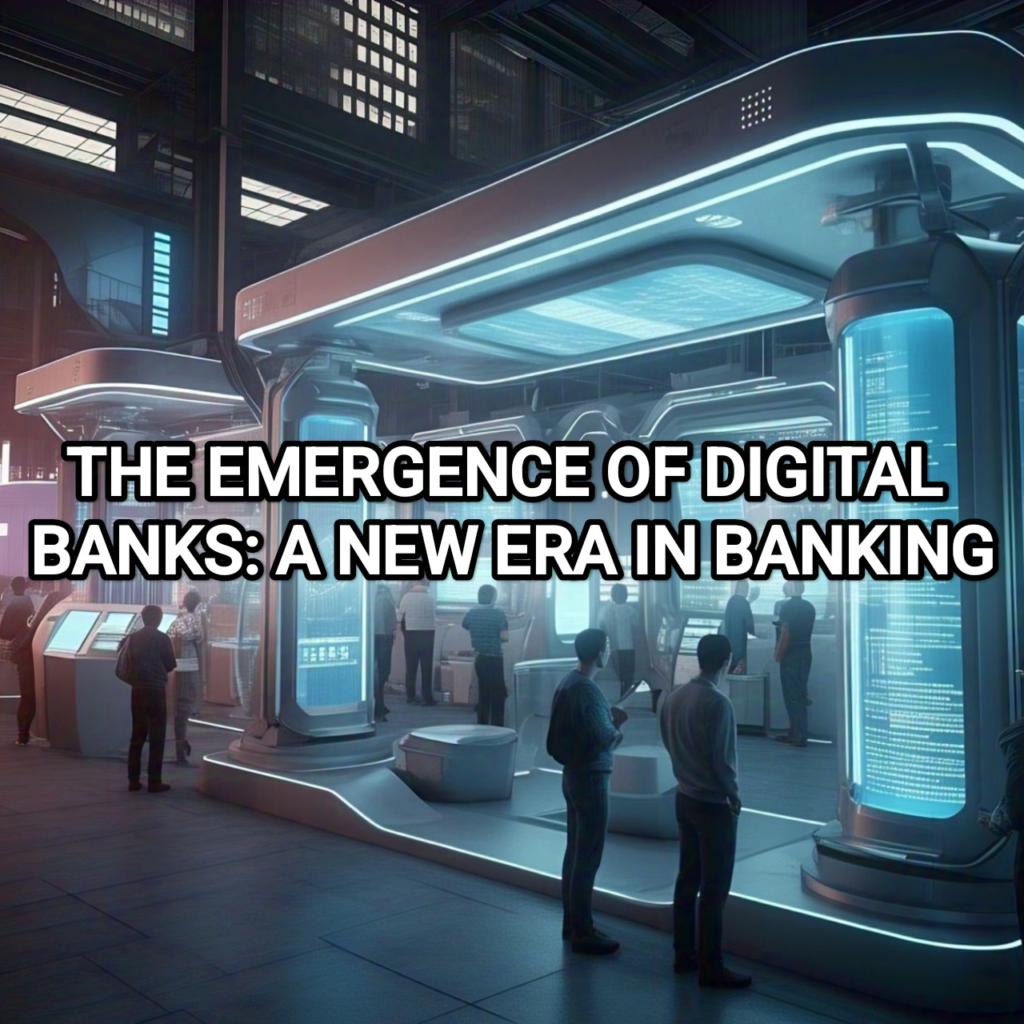
The emergence of digital banks has marked a significant shift in the banking industry, transforming the way people manage their finances and interact with financial institutions. Digital banks, also known as neobanks or challenger banks, have been gaining popularity over the past decade, driven by advances in technology, changing consumer behavior, and regulatory changes.
EARLY DAYS OF DIGITAL BANKING
The concept of digital banking is not new. In the early 2000s, online-only banks began to emerge, offering basic banking services such as checking and savings accounts, bill payments, and fund transfers. These early digital banks were primarily designed to provide convenience and accessibility to customers, but they lacked the sophistication and range of services offered by traditional banks.
The Rise of Mobile Banking
The widespread adoption of smartphones and mobile devices in the late 2000s and early 2010s marked a significant turning point in the development of digital banking. Mobile banking apps became increasingly popular, enabling customers to manage their finances on-the-go. Mobile banking apps offered a range of services, including account management, bill payments, fund transfers, and mobile deposits.
THE EMERGENCE OF DIGITAL-ONLY BANKS
In the mid-2010s, a new breed of digital banks emerged, offering a range of financial services that rivaled those of traditional banks. These digital-only banks, such as Simple, Moven, and Atom Bank, were designed from the ground up to provide a digital-only banking experience. They offered a range of services, including checking and savings accounts, credit cards, loans, and investment products, all accessible through mobile apps or online platforms.
Regulatory Changes
Regulatory changes have also played a significant role in the emergence of digital banks. In the European Union, for example, the Payment Services Directive (PSD2) came into effect in 2018, requiring banks to provide access to customer account data to third-party providers. This has enabled digital banks to access customer account data and provide payment initiation services, further blurring the lines between traditional and digital banks.
KEY DRIVERS OF DIGITAL BANK EMERGENCE
Several key drivers have contributed to the emergence of digital banks:
1. Advances in Technology: Advances in digital technologies, such as cloud computing, artificial intelligence, and blockchain, have enabled the development of digital banks.
2. Changing Consumer Behavior: Consumers are increasingly using digital channels to manage their finances, creating demand for digital banking services.
3. Regulatory Changes: Regulatory changes, such as PSD2, have created opportunities for digital banks to operate.
4. Increased Competition: The rise of fintech companies and digital payment platforms has increased competition in the financial services industry, driving traditional banks to innovate and digital banks to emerge.
IMPORTANCE OF DIGITAL BANKS IN THE FINANCIAL INDUSTRY
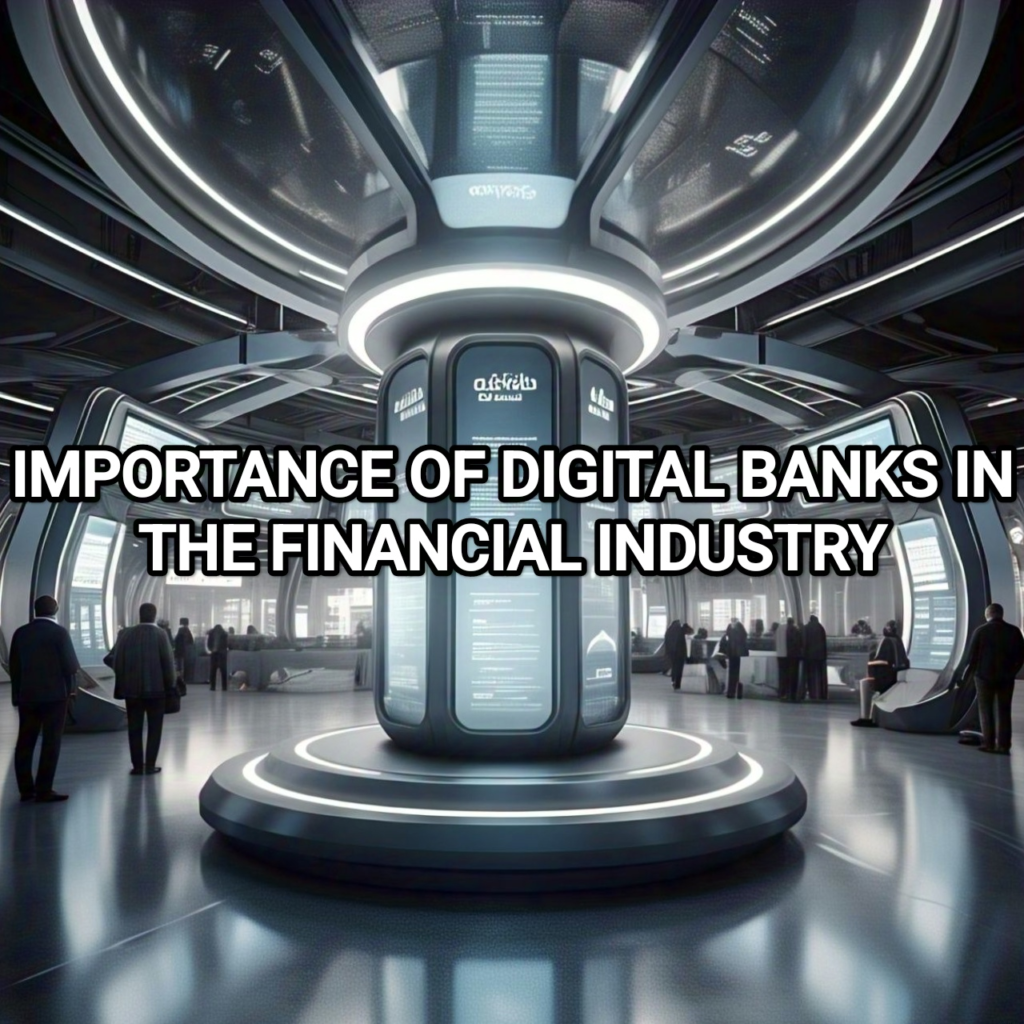
The importance of digital banks in the financial industry cannot be overstated. As the world becomes increasingly digital, the way people bank and manage their finances is also undergoing a significant transformation. Digital banks are at the forefront of this revolution, offering a range of benefits and advantages that are changing the face of the financial industry.
INCREASED ACCESSIBILITY AND CONVENIENCE
One of the most significant advantages of digital banks is their ability to provide customers with increased accessibility and convenience. With digital banks, customers can manage their finances, make transactions, and access credit from anywhere, at any time. This is particularly beneficial for individuals who live in remote or underserved areas, where traditional banking services may not be readily available.
Digital banks also offer a range of digital channels, such as mobile apps, online banking platforms, and social media, which enable customers to interact with their bank in a way that is convenient and comfortable for them. This not only improves the overall customer experience but also reduces the need for physical branch visits, which can be time-consuming and costly.
IMPROVED EFFICIENCY AND REDUCED COSTS
Digital banks are also more efficient and cost-effective than traditional banks. By leveraging digital technologies, such as cloud computing, artificial intelligence, and blockchain, digital banks can automate many of their processes, reducing the need for manual intervention and minimizing the risk of human error.
This increased efficiency enables digital banks to offer lower fees and more competitive interest rates, which can help customers save money and achieve their financial goals. Additionally, digital banks can use data analytics and machine learning to better understand their customers’ needs and preferences, enabling them to offer more personalized and relevant financial products and services.
ENHANCED SECURITY AND RISK MANAGEMENT
Digital banks also offer enhanced security and risk management capabilities, which are critical in today’s digital age. By using advanced technologies, such as biometric authentication, encryption, and fraud detection, digital banks can protect their customers’ data and transactions from cyber threats and other forms of financial crime.
Moreover, digital banks can use data analytics and machine learning to identify and mitigate potential risks, such as credit risk, market risk, and operational risk. This enables them to make more informed decisions and take proactive measures to minimize potential losses.
INCREASED COMPETITION AND INNOVATION
The rise of digital banks has also increased competition and innovation in the financial industry. By offering new and innovative financial products and services, digital banks are forcing traditional banks to rethink their business models and invest in digital technologies.
This increased competition is benefiting consumers, who now have access to a wider range of financial products and services than ever before. Additionally, the innovation and experimentation that digital banks are driving are helping to address some of the long-standing challenges and inefficiencies in the financial industry.
FINANCIAL INCLUSION AND SOCIAL IMPACT
Finally, digital banks have the potential to promote financial inclusion and social impact. By offering digital financial services to underserved populations, digital banks can help to reduce poverty, inequality, and financial exclusion.
Moreover, digital banks can use their digital platforms to promote financial literacy, education, and awareness, which can help to empower individuals and communities to take control of their financial lives.
As the financial industry continues to evolve and transform, it is likely that digital banks will play an increasingly important role in shaping the future of banking and finance.
THE RISE OF DIGITAL BANKS: A NEW ERA IN BANKING
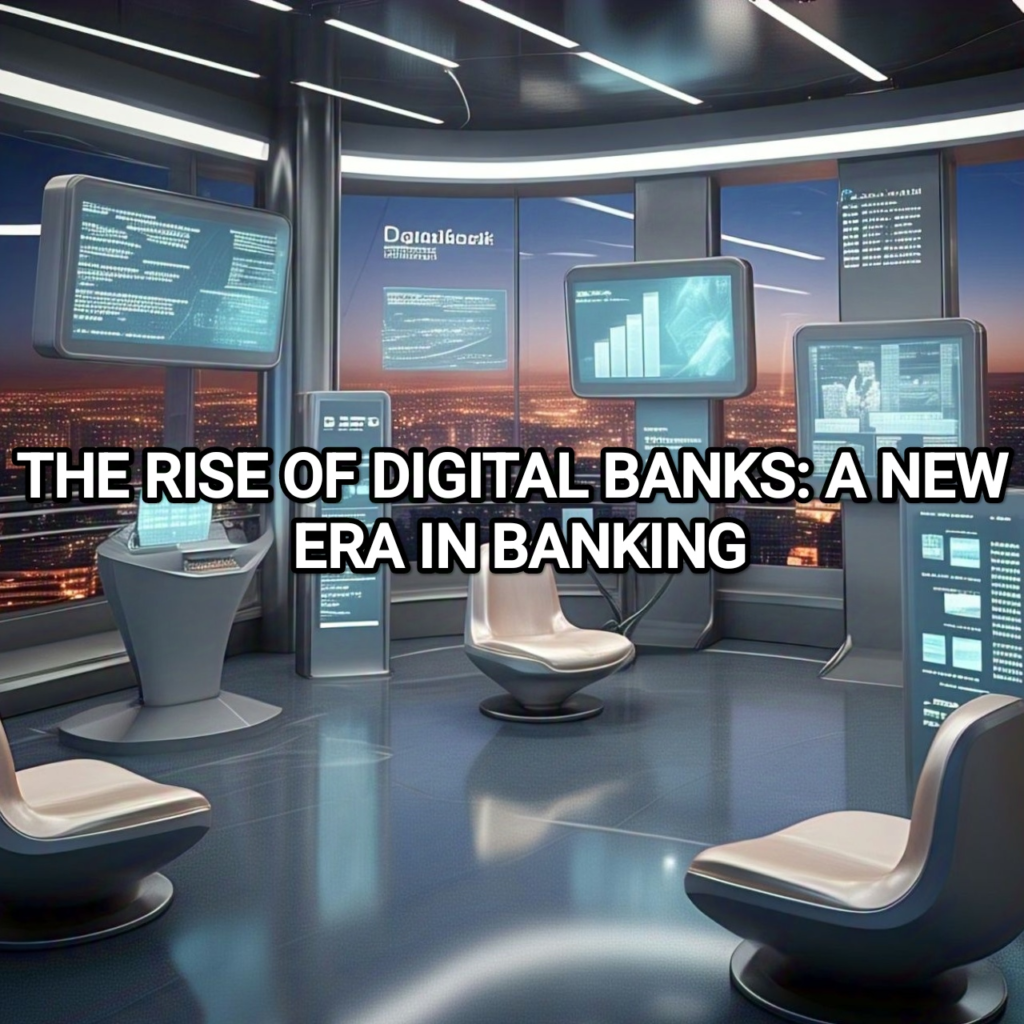
The rise of digital banks has been a significant development in the banking industry, transforming the way people manage their finances and interact with financial institutions. Digital banks, also known as neobanks or challenger banks, have been gaining popularity over the past decade, driven by advances in technology, changing consumer behavior, and regulatory changes.
EARLY ADOPTERS AND PIONEERS
The concept of digital banking is not new. In the early 2000s, online-only banks began to emerge, offering basic banking services such as checking and savings accounts, bill payments, and fund transfers. These early digital banks were primarily designed to provide convenience and accessibility to customers, but they lacked the sophistication and range of services offered by traditional banks.
However, it was the launch of mobile-only banks such as Simple and Moven in the United States, and Atom Bank in the United Kingdom, that marked the beginning of the digital banking revolution. These banks were designed from the ground up to provide a digital-only banking experience, with mobile apps and online platforms that offered a range of financial services.
KEY DRIVERS OF THE RISE OF DIGITAL BANKS
Several key drivers have contributed to the rise of digital banks:
1. Advances in Technology: Advances in digital technologies, such as cloud computing, artificial intelligence, and blockchain, have enabled the development of digital banks.
2. Changing Consumer Behavior: Consumers are increasingly using digital channels to manage their finances, creating demand for digital banking services.
3. Regulatory Changes: Regulatory changes, such as the Payment Services Directive (PSD2) in the European Union, have created opportunities for digital banks to operate.
4. Increased Competition: The rise of fintech companies and digital payment platforms has increased competition in the financial services industry, driving traditional banks to innovate and digital banks to emerge.
CHARACTERISTICS OF DIGITAL BANKS
Digital banks are characterized by several key features, including:
1. Digital-Only: Digital banks operate entirely online or through mobile apps, without physical branches.
2. Mobile-First: Digital banks prioritize mobile devices as the primary channel for customer interaction.
3. Cloud-Based: Digital banks use cloud-based infrastructure to support their operations.
4. API-Based: Digital banks use application programming interfaces (APIs) to integrate with other financial institutions and third-party providers.
5. Data-Driven: Digital banks use data analytics and machine learning to inform their decision-making and improve customer experiences.
HOW ARE DIGITAL BANKS CHANGING THE INDUSTRY?
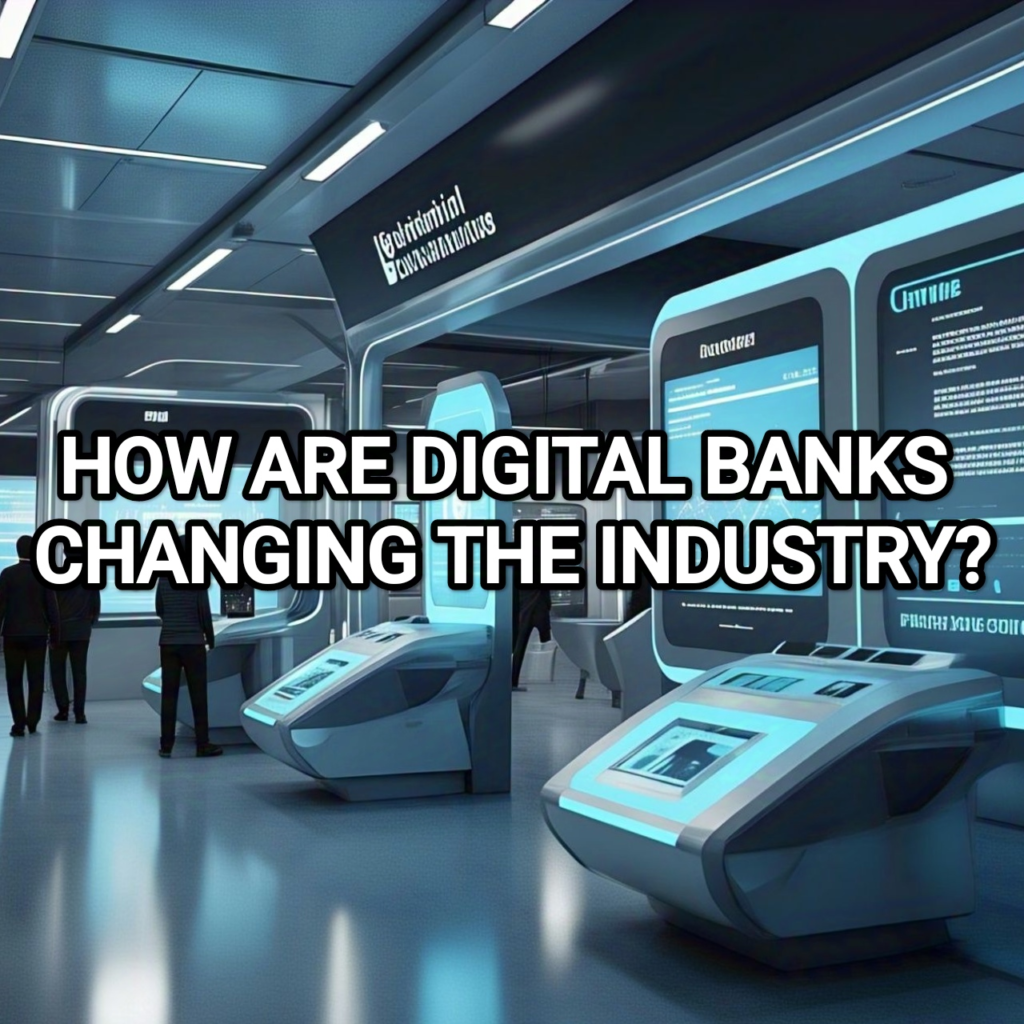
Digital banks are disrupting the banking industry in several ways:
1. Shift from Traditional Branch-Based Banking to Digital-Only Banking
Digital banks are changing the way people bank by shifting from traditional branch-based banking to digital-only banking. With digital banks, customers can manage their finances entirely online or through mobile apps, eliminating the need for physical branch visits. This shift has significant implications for traditional banks, which must adapt to the changing needs of customers and invest in digital technologies to remain competitive.
2. Increased Competition and Innovation
Digital banks are increasing competition and innovation in the banking industry, driving traditional banks to innovate and improve their services. Digital banks are leveraging advanced technologies, such as artificial intelligence, blockchain, and cloud computing, to offer innovative financial products and services that meet the evolving needs of customers. This increased competition and innovation are benefiting customers, who now have access to a wider range of financial services and products.
3. Improved Customer Experience
Digital banks are improving the customer experience by offering personalized financial services and advice, tailored to individual customer needs and preferences. Digital banks are leveraging data analytics and machine learning to analyze customer data and behavior, and offer targeted financial advice and recommendations. This personalized approach is enabling customers to make informed decisions about their finances and achieve their financial goals.
4. Reduced Costs and Increased Efficiency
Digital banks are reducing costs and increasing efficiency by leveraging digital technologies and automation. Digital banks are eliminating the need for physical branches, paper-based processes, and manual intervention, which reduces costs and increases efficiency. This reduced cost structure enables digital banks to offer lower fees and more competitive interest rates, which benefits customers and drives growth.
5. Increased Financial Inclusion
Digital banks are increasing financial inclusion by providing access to financial services for underserved populations. Digital banks are leveraging digital technologies to reach and serve customers in remote or underserved areas, where traditional banks may not have a presence. This increased financial inclusion is promoting financial stability and prosperity, and contributing to the economic development of underserved communities.
6. Changing Business Models
Digital banks are changing traditional banking business models by offering new and innovative financial products and services. Digital banks are leveraging digital technologies to offer peer-to-peer lending, crowdfunding, and robo-advisory services, which are disrupting traditional banking business models. This shift is enabling digital banks to generate new revenue streams and drive growth.
7. Regulatory Changes
Digital banks are driving regulatory changes by pushing the boundaries of traditional banking regulations. Digital banks are leveraging digital technologies to offer new and innovative financial products and services, which are not always covered by existing regulations. This is driving regulatory bodies to review and update existing regulations to accommodate the changing needs of the industry.
8. Talent Acquisition and Retention
Digital banks are changing the way banks attract and retain talent by offering new and innovative career opportunities. Digital banks are leveraging digital technologies to offer flexible and remote working arrangements, which are attracting top talent from the fintech and tech industries. This shift is enabling digital banks to build diverse and skilled teams that can drive innovation and growth.
9. Partnerships and Collaborations
Digital banks are changing the way banks partner and collaborate with other financial institutions and fintech companies. Digital banks are leveraging digital technologies to offer open banking platforms and APIs, which enable partnerships and collaborations with other financial institutions and fintech companies. This shift is enabling digital banks to offer new and innovative financial products and services, and drive growth.
10. Future of Banking
Digital banks are changing the future of banking by offering new and innovative financial products and services that meet the evolving needs of customers. Digital banks are leveraging digital technologies to offer personalized financial services and advice, tailored to individual customer needs and preferences. This shift is enabling digital banks to drive growth, increase financial inclusion, and promote financial stability and prosperity.
BENEFITS OF DIGITAL BANKS

Digital banks offer numerous benefits to consumers, including:
1. Convenience and Accessibility
One of the most significant benefits of digital banks is their convenience and accessibility. Digital banks operate entirely online or through mobile apps, enabling customers to manage their finances from anywhere, at any time. This approach eliminates the need for physical branch visits, which can be time-consuming and inconvenient.
Digital banks also offer a range of digital channels, such as mobile apps, online banking platforms, and social media, which enable customers to interact with their bank in a way that is convenient and comfortable for them. This approach enables customers to bank on their own terms, without being restricted by traditional banking hours or branch locations.
2. Lower Fees and Charges
Digital banks often have lower fees and charges compared to traditional banks. This is because digital banks have lower operational costs, which they can pass on to customers in the form of lower fees and charges. Digital banks also offer transparent and straightforward pricing, which enables customers to easily understand and manage their fees and charges.
3. Personalized Financial Services
Digital banks offer personalized financial services and advice, tailored to individual customer needs and preferences. This approach is facilitated by digital banks’ use of data analytics and machine learning, which enable them to analyze customer data and behavior, and offer targeted financial advice and recommendations.
Personalized financial services enable customers to make informed decisions about their finances, and to achieve their financial goals. Digital banks also offer a range of financial tools and resources, such as budgeting apps and financial calculators, which enable customers to manage their finances more effectively.
4. Real-Time Transactions and Updates
Digital banks enable real-time transactions and updates, enabling customers to transfer funds and make payments quickly and efficiently. Real-time transactions are facilitated by digital banks’ use of advanced technologies, such as blockchain and cloud computing.
Real-time transactions and updates enable customers to manage their finances more effectively, and to respond quickly to changing financial circumstances. Digital banks also offer real-time alerts and notifications, which enable customers to stay informed about their account activity and transactions.
5. Enhanced Security and Risk Management
Digital banks use advanced security measures, such as biometric authentication, encryption, and two-factor authentication, to protect customer data and transactions. Enhanced security measures enable digital banks to provide customers with a secure and trustworthy banking experience.
Digital banks also use advanced technologies, such as machine learning and artificial intelligence, to detect and prevent cyber threats. This approach enables digital banks to stay ahead of emerging threats, and to protect customer data and transactions more effectively.
6. Improved Customer Experience
Digital banks prioritize customer experience and satisfaction, offering a range of features and services designed to meet individual customer needs and preferences. Improved customer experience enables digital banks to build trust and loyalty with their customers, and to differentiate themselves from traditional banks.
Digital banks also offer a range of customer support channels, such as phone, email, and live chat, which enable customers to quickly and easily resolve any issues or concerns they may have. Improved customer experience enables digital banks to provide customers with a more personalized and supportive banking experience.
7. Increased Financial Inclusion
Digital banks are improving financial inclusion by providing access to financial services for underserved populations. Digital banks offer a range of financial services, including checking and savings accounts, credit cards, and loans, which are designed to meet the needs of low-income and marginalized communities.
Digital banks also offer financial education and literacy programs, which enable customers to develop the skills and knowledge they need to manage their finances more effectively. Increased financial inclusion enables digital banks to promote financial stability and prosperity, and to contribute to the economic development of underserved communities.
8. Environmental Sustainability
Digital banks are promoting environmental sustainability by reducing their carbon footprint and promoting eco-friendly banking practices. Digital banks offer paperless banking, which reduces the need for paper statements and documents.
Digital banks also offer digital payment solutions, which reduce the need for cash and checks. Environmental sustainability enables digital banks to promote eco-friendly banking practices, and to contribute to a more sustainable future.
9. Increased Competition and Innovation
Digital banks are increasing competition and innovation in the banking industry, driving traditional banks to innovate and improve their services. Increased competition and innovation enable digital banks to promote financial stability and prosperity, and to contribute to the economic development of communities.
10. Improved Regulatory Compliance
Digital banks are improving regulatory compliance by leveraging advanced technologies, such as artificial intelligence and machine learning, to detect and prevent financial crime. Improved regulatory compliance enables digital banks to promote financial stability and prosperity, and to contribute to the economic development of communities.
CHALLENGES FACING DIGITAL BANKS
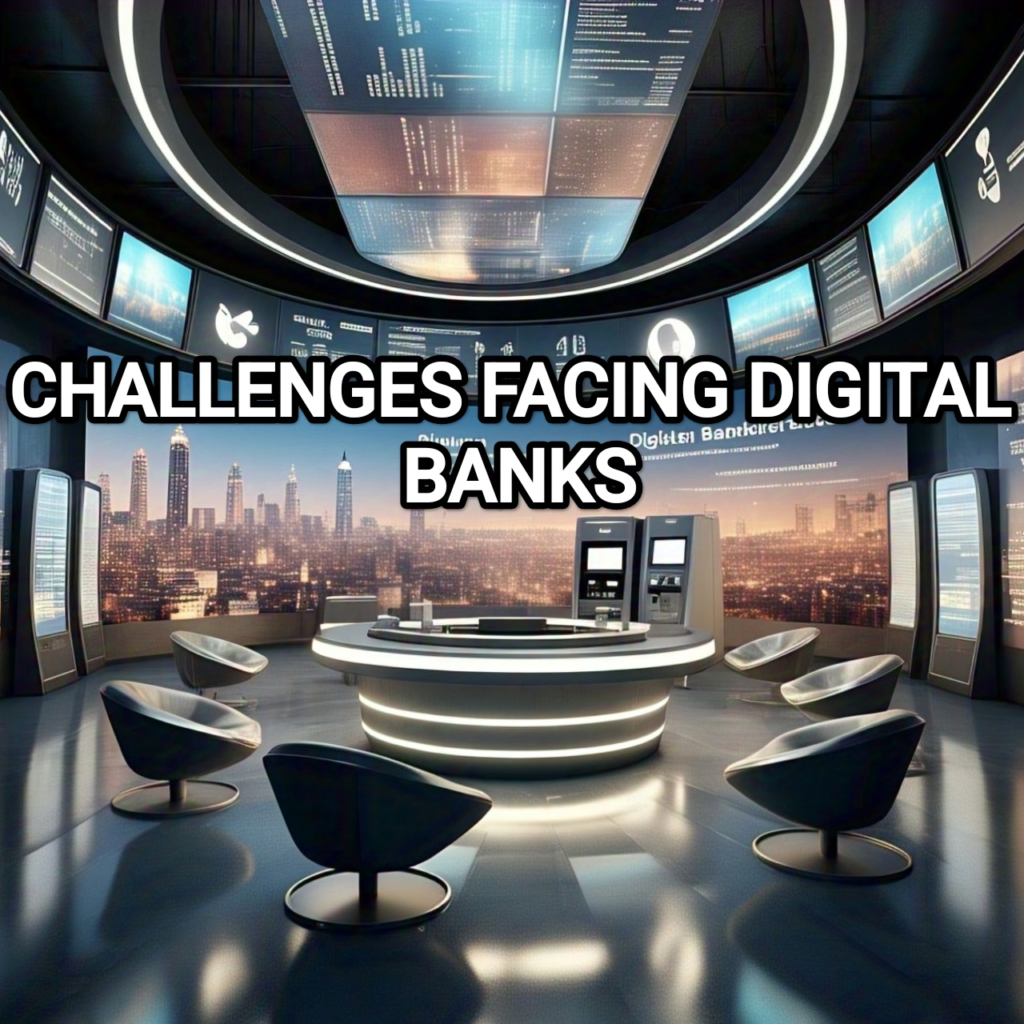
1. Regulatory Compliance
One of the biggest challenges facing digital banks is regulatory compliance. Digital banks must comply with a range of regulations, including anti-money laundering (AML) and know-your-customer (KYC) requirements, as well as data protection and privacy regulations. Ensuring compliance with these regulations can be complex and time-consuming, and can require significant investment in technology and personnel.
2. Cybersecurity
Digital banks are also vulnerable to cybersecurity threats, including hacking, phishing, and other forms of cybercrime. Protecting customer data and transactions from these threats is critical, and requires significant investment in cybersecurity measures, including encryption, firewalls, and intrusion detection systems.
3. Customer Adoption
Another challenge facing digital banks is customer adoption. Many customers are hesitant to adopt digital banking services, due to concerns about security, convenience, and accessibility. Digital banks must invest in marketing and education efforts to raise awareness about their services and build trust with potential customers.
4. Competition from Traditional Banks
Digital banks also face competition from traditional banks, which are increasingly investing in digital technologies to improve their own services. Traditional banks have a number of advantages, including established brands, large customer bases, and extensive branch networks. Digital banks must differentiate themselves from traditional banks by offering unique services, features, and experiences that meet the evolving needs of customers.
5. Infrastructure and Technology
Digital banks require significant investment in infrastructure and technology to support their operations. This includes investment in cloud computing, data analytics, and cybersecurity, as well as the development of mobile and online banking platforms. Ensuring that these systems are reliable, secure, and scalable is critical to the success of digital banks.
6. Talent Acquisition and Retention
Digital banks also face challenges in terms of talent acquisition and retention. Attracting and retaining skilled professionals with expertise in areas such as technology, data analytics, and cybersecurity is critical to the success of digital banks. However, competition for talent is fierce, and digital banks must offer competitive salaries, benefits, and career development opportunities to attract and retain the best talent.
7. Financial Inclusion
Digital banks also face challenges in terms of financial inclusion. Many customers in underserved communities lack access to traditional banking services, and digital banks must develop strategies to reach and serve these customers. This may involve investing in financial education and literacy programs, as well as developing products and services that meet the unique needs of underserved communities.
8. Risk Management
Digital banks also face challenges in terms of risk management. Digital banks must develop strategies to manage a range of risks, including credit risk, market risk, and operational risk. This requires significant investment in risk management systems and processes, as well as the development of robust risk management policies and procedures.
9. Partnerships and Collaborations
Digital banks also face challenges in terms of partnerships and collaborations. Digital banks must develop partnerships with other financial institutions, fintech companies, and technology providers to support their operations and offer a range of services to customers. However, developing and maintaining these partnerships can be complex and time-consuming, and requires significant investment in relationship management and partnership development.
10. Scalability
Finally, digital banks face challenges in terms of scalability. As digital banks grow and expand their customer base, they must ensure that their systems and processes can scale to meet increasing demand. This requires significant investment in technology and infrastructure, as well as the development of robust processes and procedures to support growth and expansion.
DIGITAL BANKING BUSINESS MODELS

Digital banking business models are revolutionizing the future of banking by providing customers with convenient, efficient, and personalized financial services. Digital banks are leveraging advanced technologies, such as artificial intelligence, blockchain, and cloud computing, to offer innovative financial products and services that meet the evolving needs of customers. In this section, we will explore the different digital banking business models and how they are changing the industry.
1. Neobanking Business Model
Neobanking is a digital banking business model that involves offering banking services entirely online or through mobile apps. Neobanks do not have physical branches and rely on digital channels to interact with customers. Neobanks offer a range of financial services, including checking and savings accounts, credit cards, and loans. Neobanks are able to offer lower fees and more competitive interest rates due to their lower operational costs.
2. Challenger Banking Business Model
Challenger banking is a digital banking business model that involves offering banking services to underserved or niche markets. Challenger banks use digital channels to reach and serve customers who may not have access to traditional banking services. Challenger banks offer a range of financial services, including checking and savings accounts, credit cards, and loans. Challenger banks are able to offer more personalized and tailored financial services due to their focus on specific markets.
3. Open Banking Business Model
Open banking is a digital banking business model that involves providing customers with secure and controlled access to their financial data. Open banking enables customers to share their financial data with third-party providers, such as fintech companies and other banks. Open banking business models rely on application programming interfaces (APIs) to facilitate the sharing of financial data. Open banking business models are able to offer customers more personalized and tailored financial services due to the sharing of financial data.
4. Platform Banking Business Model
Platform banking is a digital banking business model that involves offering banking services through a platform that integrates multiple financial services and products. Platform banking business models rely on APIs to integrate multiple financial services and products. Platform banking business models are able to offer customers a one-stop-shop for all their financial needs. Platform banking business models are also able to offer more personalized and tailored financial services due to the integration of multiple financial services and products.
5. Marketplace Banking Business Model
Marketplace banking is a digital banking business model that involves offering banking services through a marketplace that connects customers with multiple financial service providers. Marketplace banking business models rely on APIs to connect customers with multiple financial service providers. Marketplace banking business models are able to offer customers a range of financial services and products from multiple providers. Marketplace banking business models are also able to offer more personalized and tailored financial services due to the connection with multiple financial service providers.
6. Hybrid Banking Business Model
Hybrid banking is a digital banking business model that involves offering banking services through a combination of physical and digital channels. Hybrid banking business models rely on a combination of physical branches and digital channels to interact with customers. Hybrid banking business models are able to offer customers a range of financial services and products through multiple channels. Hybrid banking business models are also able to offer more personalized and tailored financial services due to the combination of physical and digital channels.
KEY CHARACTERISTICS OF DIGITAL BANKING BUSINESS MODELS
Digital banking business models have several key characteristics that enable them to offer customers convenient, efficient, and personalized financial services. These characteristics include:
1. Digital-only or hybrid channels: Digital banking business models rely on digital channels, such as mobile apps and online platforms, to interact with customers.
2. API-based integration: Digital banking business models rely on APIs to integrate multiple financial services and products.
3. Data-driven decision making: Digital banking business models rely on data analytics and machine learning to inform decision making and offer personalized financial services.
4. Cloud-based infrastructure: Digital banking business models rely on cloud-based infrastructure to support their operations and offer scalable and secure financial services.
5. Customer-centric approach: Digital banking business models prioritize customer experience and satisfaction, offering personalized and tailored financial services that meet the evolving needs of customers.
DIGITAL BANKING TECHNOLOGIES
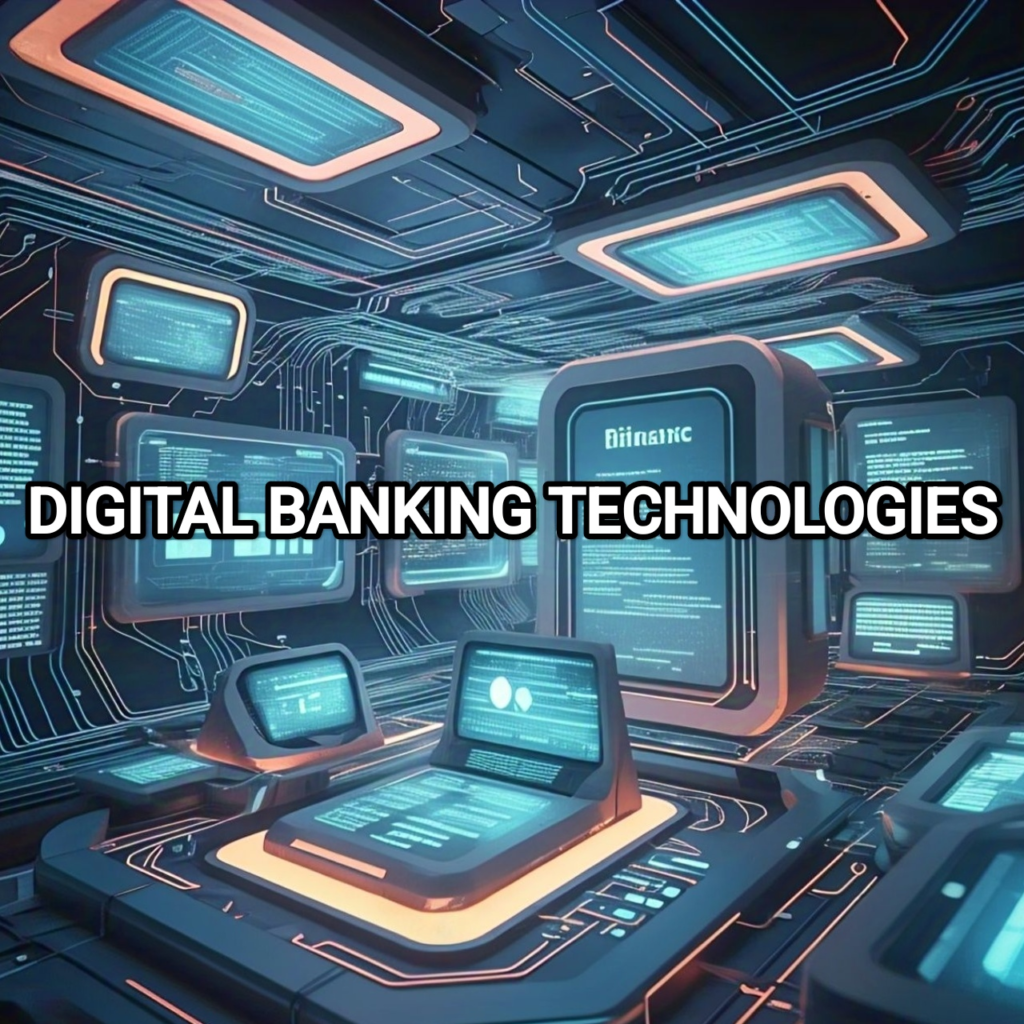
Digital banking technologies are revolutionizing the future of banking by providing customers with convenient, efficient, and personalized financial services. Digital banks are leveraging advanced technologies, such as artificial intelligence, blockchain, and cloud computing, to offer innovative financial products and services that meet the evolving needs of customers. In this section, we will explore the digital banking technologies that are changing the industry.
1. Cloud Computing
Cloud computing is a digital banking technology that enables banks to store and process data remotely, reducing the need for physical infrastructure and increasing scalability. Cloud computing enables banks to offer customers a range of financial services and products, including online banking, mobile banking, and digital payments.
2. Artificial Intelligence (AI)
Artificial intelligence (AI) is a digital banking technology that enables banks to analyze customer data and behavior, and offer personalized financial services and advice. AI-powered chatbots and virtual assistants are also being used to provide customers with 24/7 support and assistance.
3. Blockchain
Blockchain is a digital banking technology that enables secure and transparent transactions, reducing the risk of fraud and cybercrime. Blockchain technology is being used to facilitate cross-border payments, securities settlement, and identity verification.
4. Mobile Banking
Mobile banking is a digital banking technology that enables customers to manage their finances on-the-go, using mobile devices such as smartphones and tablets. Mobile banking apps provide customers with a range of financial services and products, including account management, bill payments, and fund transfers.
5. Digital Payments
Digital payments are a digital banking technology that enables customers to make payments online or through mobile devices, using digital payment methods such as credit cards, debit cards, and e-wallets. Digital payments are convenient, efficient, and secure, reducing the need for cash and checks.
6. Biometric Authentication
Biometric authentication is a digital banking technology that enables customers to access their accounts and conduct transactions using biometric data such as fingerprints, facial recognition, and voice recognition. Biometric authentication is secure, convenient, and efficient, reducing the risk of identity theft and cybercrime.
7. Big Data Analytics
Big data analytics is a digital banking technology that enables banks to analyze large amounts of customer data and behavior, and offer personalized financial services and advice. Big data analytics is also being used to detect and prevent financial crime, and to improve operational efficiency.
8. Internet of Things (IoT)
Internet of Things (IoT) is a digital banking technology that enables banks to connect with customers through a range of devices, including smartphones, wearables, and smart home devices. IoT technology is being used to offer customers personalized financial services and advice, and to improve operational efficiency.
9. Robotic Process Automation (RPA)
Robotic process automation (RPA) is a digital banking technology that enables banks to automate repetitive and manual tasks, improving operational efficiency and reducing costs. RPA technology is being used to automate tasks such as account opening, loan processing, and customer service.
10. Application Programming Interfaces (APIs)
Application programming interfaces (APIs) are a digital banking technology that enables banks to connect with third-party providers and offer customers a range of financial services and products. APIs are being used to facilitate open banking, enabling customers to share their financial data with third-party providers and access a range of financial services and products.
KEY BENEFITS OF DIGITAL BANKING TECHNOLOGIES
Digital banking technologies offer a range of benefits to customers, including:
1. Convenience: Digital banking technologies enable customers to manage their finances on-the-go, using mobile devices and online platforms.
2. Efficiency: Digital banking technologies automate repetitive and manual tasks, improving operational efficiency and reducing costs.
3. Personalization: Digital banking technologies enable banks to analyze customer data and behavior, and offer personalized financial services and advice.
4. Security: Digital banking technologies enable banks to detect and prevent financial crime, and to improve operational security.
5. Innovation: Digital banking technologies enable banks to offer customers a range of innovative financial services and products, improving customer experience and driving growth.
FREQUENTLY ASKED QUESTIONS
Q1: What is a digital bank?
A digital bank is a bank that operates entirely online or through mobile apps, without physical branches. Digital banks offer a range of financial services, including checking and savings accounts, credit cards, and loans.
Q2: How do digital banks differ from traditional banks?
Digital banks differ from traditional banks in several ways. They operate entirely online or through mobile apps, without physical branches. They also offer more personalized and tailored financial services, using data analytics and machine learning to inform their decision-making.
Q3: What are the benefits of digital banks?
The benefits of digital banks include convenience, efficiency, and personalized financial services. Digital banks also offer lower fees and more competitive interest rates, due to their lower operational costs.
Q4: Are digital banks secure?
Yes, digital banks are secure. They use advanced security measures, such as encryption, firewalls, and two-factor authentication, to protect customer data and transactions.
Q5: Can I trust digital banks with my money?
Yes, you can trust digital banks with your money. Digital banks are regulated by financial authorities and are subject to the same regulatory requirements as traditional banks.
Q6: How do digital banks make money?
Digital banks make money through a range of channels, including interest on loans, transaction fees, and interchange fees.
Q7: What is the future of digital banking?
The future of digital banking is likely to involve further innovation and adoption of new technologies, such as artificial intelligence, blockchain, and the Internet of Things (IoT).
Q8: Will digital banks replace traditional banks?
It is unlikely that digital banks will replace traditional banks entirely. Instead, digital banks will likely coexist with traditional banks, offering customers a range of choices and options for managing their finances.
Q9: How can I get started with digital banking?
To get started with digital banking, you can start by researching and comparing different digital banks and their offerings. You can also read reviews and ask for recommendations from friends and family.
Q10: What are the risks of digital banking?
The risks of digital banking include cybersecurity risks, such as hacking and phishing, as well as the risk of technical failures and outages. However, digital banks are taking steps to mitigate these risks and protect customer data and transactions.
Q11: Can I use digital banking services if I don’t have a smartphone?
Yes, you can use digital banking services even if you don’t have a smartphone. Many digital banks offer online banking platforms that can be accessed through a computer or tablet.
Q12: How do digital banks handle customer support?
Digital banks offer customer support through a range of channels, including phone, email, and live chat. Many digital banks also offer 24/7 customer support, enabling customers to get help whenever they need it.
THINGS TO AVOID
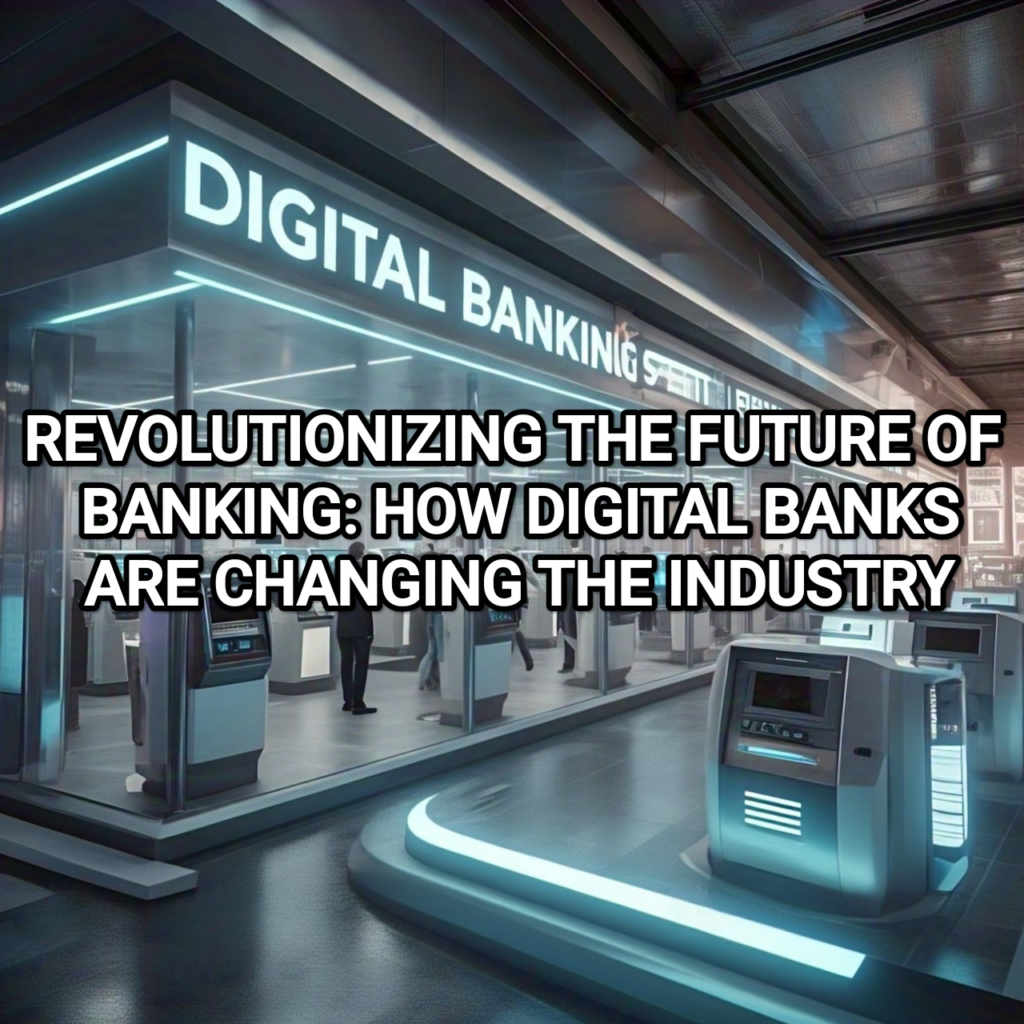
As digital banks continue to revolutionize the future of banking, there are several things to avoid in order to ensure a successful and secure digital banking experience. Here are some key things to avoid:
1. Lack of Security Measures
Digital banks must prioritize security measures to protect customer data and transactions. Avoid using weak passwords, outdated encryption methods, and inadequate firewalls.
2. Poor User Experience
A poor user experience can lead to customer frustration and abandonment. Avoid cluttered and confusing interfaces, slow loading times, and inadequate customer support.
3. Insufficient Regulation and Compliance
Digital banks must comply with regulatory requirements and industry standards. Avoid ignoring or circumventing regulations, and ensure that your digital bank is transparent and accountable.
4. Inadequate Risk Management
Digital banks must manage risk effectively to protect customers and maintain stability. Avoid ignoring or downplaying potential risks, and ensure that your digital bank has robust risk management processes in place.
5. Lack of Transparency and Accountability
Digital banks must be transparent and accountable to customers and regulators. Avoid hiding fees, charges, or terms and conditions, and ensure that your digital bank is transparent about its operations and decision-making processes.
6. Inadequate Customer Support
Digital banks must provide adequate customer support to help customers navigate the digital banking experience. Avoid providing inadequate or unresponsive customer support, and ensure that your digital bank has multiple channels for customer support.
7. Failure to Innovate and Adapt
Digital banks must innovate and adapt to changing customer needs and technological advancements. Avoid becoming complacent or stagnant, and ensure that your digital bank is continuously innovating and improving its services.
8. Ignoring Customer Feedback and Concerns
Digital banks must listen to customer feedback and concerns to improve the digital banking experience. Avoid ignoring or dismissing customer feedback, and ensure that your digital bank is responsive to customer concerns.
9. Lack of Collaboration and Partnerships
Digital banks must collaborate and partner with other financial institutions, fintech companies, and technology providers to offer innovative services and improve the digital banking experience. Avoid going it alone, and ensure that your digital bank is actively seeking out collaborations and partnerships.
10. Failure to Address Cybersecurity Threats
Digital banks must prioritize cybersecurity to protect customer data and transactions. Avoid ignoring or downplaying cybersecurity threats, and ensure that your digital bank has robust cybersecurity measures in place to detect and prevent cyber threats.
By avoiding these common pitfalls, digital banks can ensure a successful and secure digital banking experience for customers, and continue to revolutionize the future of banking.
CONCLUSION
In conclusion, digital banks are revolutionizing the future of banking by providing customers with convenient, efficient, and personalized financial services. The rise of digital banks has disrupted the traditional banking industry, forcing banks to adapt and innovate in order to remain competitive.
Digital banks have several key advantages over traditional banks, including lower operational costs, greater convenience, and more personalized services. However, they also face several challenges, including regulatory hurdles, cybersecurity threats, and the need to balance innovation with risk management.
As the banking industry continues to evolve, it is clear that digital banks will play an increasingly important role in shaping the future of banking. Customers are demanding more convenient, efficient, and personalized financial services, and digital banks are well-positioned to meet these demands.
CALL TO ACTION
So, what can traditional banks and financial institutions do to remain competitive in this rapidly changing landscape?
1. Invest in digital transformation: Traditional banks must invest in digital transformation to remain competitive. This includes investing in new technologies, such as cloud computing, artificial intelligence, and blockchain.
2. Develop a customer-centric approach: Traditional banks must develop a customer-centric approach to banking, focusing on providing convenient, efficient, and personalized financial services.
3. Collaborate with fintech companies: Traditional banks must collaborate with fintech companies to leverage their expertise and innovative solutions.
4. Prioritize cybersecurity: Traditional banks must prioritize cybersecurity to protect customer data and transactions.
5. Stay ahead of regulatory changes: Traditional banks must stay ahead of regulatory changes to ensure compliance and avoid fines.
By taking these steps, traditional banks and financial institutions can remain competitive in the rapidly changing banking landscape and provide customers with the convenient, efficient, and personalized financial services they demand.
The Future of Banking
The future of banking is digital, and it is clear that digital banks will play an increasingly important role in shaping the industry. As technology continues to evolve, we can expect to see even more innovative solutions and services emerge.
One thing is certain: The banking industry will never be the same again. The rise of digital banks has disrupted the traditional banking industry, and it is up to traditional banks and financial institutions to adapt and innovate in order to remain competitive.
The future of banking is exciting, and it is clear that digital banks will be at the forefront of this revolution.
ABOUT AUTHOR
Shanel John is a dedicated Certified Public Accountant (CPA) at G.L.H. Accounting, specializing in Income Tax with 10 years of experience. Based in Brampton, Ontario, Canada, Shanel offers expertise in tax preparation, financial accounting, and advisory services. A certified QBO Pro Advisor, Shanel’s decade-long experience and knowledge make her a trusted figure in the accounting field.
